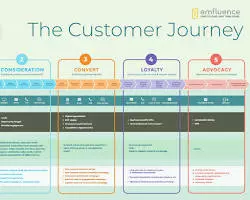Mastering the Customer Journey with CRM: Elevate Experiences and Boost Loyalty in 2024

Customer Journey Mapping with CRM Software
In today’s customer-centric landscape, understanding and optimizing the customer journey is paramount for business success. A customer journey map is a visual representation of the various touchpoints and interactions a customer has with your brand, from initial awareness to post-purchase experiences. By mapping this journey, businesses can gain valuable insights into customer behavior, identify pain points, and tailor experiences to meet their needs and expectations.
The Importance of Customer Journey Mapping
Customer journey mapping is a strategic tool that empowers businesses to:
- Understand the Customer Perspective: Gain a deeper understanding of how customers perceive and interact with your brand at every stage of their journey.
- Identify Pain Points: Pinpoint areas where customers may experience friction, frustration, or confusion, and take steps to address these issues.
- Personalize Experiences: Tailor experiences to meet the unique needs and preferences of customers at different stages of their journey.
- Improve Customer Satisfaction: Enhance customer satisfaction by providing seamless and personalized experiences that exceed expectations.
- Drive Loyalty and Advocacy: Build lasting relationships with customers by consistently delivering exceptional experiences throughout their journey.
How CRM Enhances Customer Journey Mapping
CRM systems play a crucial role in customer journey mapping by providing a centralized platform for collecting and analyzing customer data. Key CRM features for customer journey mapping include:
- Customer Data Collection: Track customer interactions across various channels, including website visits, email clicks, social media engagement, and purchase history.
- Journey Visualization: Create visual maps that depict the customer journey, including touch-points, emotions, pain points, and opportunities for improvement.
- Segmentation: Group customers based on their journey stage, behavior, or preferences to tailor experiences and messaging.
- Personalization: Leverage customer data to deliver personalized content, offers, and recommendations at each touch-point.
- Feedback Collection: Gather feedback from customers at various stages of their journey to identify areas for improvement and enhance the overall experience.
Best Practices for Customer Journey Mapping with CRM
To maximize the effectiveness of your customer journey mapping efforts, consider these best practices:
- Start with Your Customers: Gather feedback from customers through surveys, interviews, and focus groups to understand their needs, expectations, and pain points.
- Identify Key Touch-points: Map out all the touch-points where customers interact with your brand, from initial awareness to post-purchase support.
- Define Goals and Metrics: Clearly outline the goals of your customer journey map and identify the key metrics you will track to measure success.
- Use a Collaborative Approach: Involve stakeholders from across your organization in the customer journey mapping process to ensure a holistic view of the customer experience.
- Continuously Iterate and Improve: Regularly review and update your customer journey map based on feedback and data to ensure it remains relevant and effective.
Conclusion
Customer journey mapping is a powerful tool that enables businesses to gain a deep understanding of their customers and deliver exceptional experiences. By leveraging CRM technology, businesses can collect and analyze customer data, visualize the customer journey, and personalize experiences to meet individual needs. Embrace customer journey mapping in 2024 and unlock the full potential of your customer relationships.

Fundamentals of CRM with Dynamics 365 and Power Platform

Marketing Automation For Dummies

Successful Direct Marketing Methods: Interactive, Database, and Customer-based Marketing for Digital Age (BUSINESS BOOKS)

CRM & FFHH: analysis of real accidents

Connected CRM: Implementing a Data–Driven, Customer–Centric Business Strategy

Special Edition Using Microsoft CRM
Related Guides: See all
- AI-Powered CRM: Supercharging Customer Relationships with Intelligent Automation and Predictive Insights in 2024
- Omnichannel Engagement with CRM: Crafting Seamless Customer Journeys in 2024
- Personalization Powerhouse: How CRM Drives Customer-Centric Experiences in 2024
- Customer Segmentation Mastery with CRM: Unlock Personalized Marketing and Sales Strategies in 2024
- Social CRM: Building Stronger Customer Relationships Through Social Media in 2024
- Cloud CRM: Revolutionizing Business Agility and Scalability in 2024
- Mobile CRM: Empowering Sales and Service Teams on the Go in 2024
- CRM Integration and API: Unifying Your Business Ecosystem for Seamless Operations in 2024
- Data-Driven Decisions with CRM: Harness the Power of Reporting and Dashboards in 2024